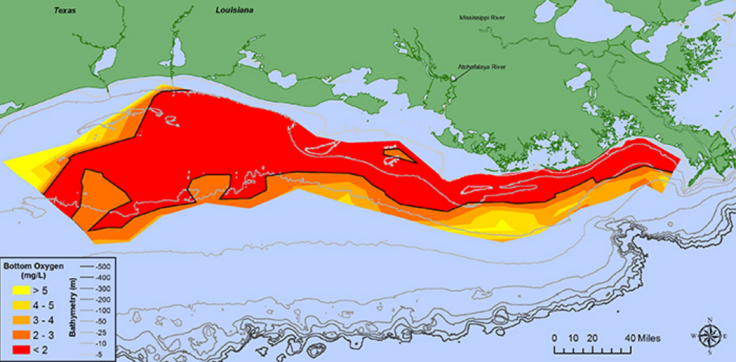Gulf Of Mexico Sees Largest 'Dead Zone' Recorded, Size Of New Jersey

A “dead zone,” which is an area of low oxygen that kills fish and marine life, appears every year in the Gulf of Mexico and is measured by scientists. This year, researchers recorded the largest dead zone, measuring the size of New Jersey, NOAA announced Wednesday.
The dead zone, located off the coast of Louisiana, measures about 8,185 square miles. The size of the area is the biggest since scientists began mapping the location in 1985.
Read: Anxiety And Social Media: Brain's Addiction To Checking Accounts
The deadzone has been fueled by agriculture and wastewater. Nutrient pollution from agriculture, due to the use of fertilizers in the Midwest, and developed land runoff in the Mississippi River, has negatively impacted the Gulf of Mexico.
Scientists from Louisiana State University and the Louisiana Universities Marine Consortium collected data to find out the size of the dead zone aboard the R/V Pelican from July 24 to July 31.
“We expected one of the largest zones ever recorded because the Mississippi River discharge levels, and the May data indicated a high delivery of nutrients during this critical month which stimulates the mid-summer dead zone,” Nancy Rabalais, a research professor at LSU, said in a statement.
The LSU and LUMC emphasized that the entire area was not mapped because of insufficient days on the ship, meaning the dead zone is larger. Researchers said there was more hypoxia to the west, but ran out of time to map it.
Negative Impacts Of The Dead Zone
The nutrients that pour from the river lead to a massive growth of algae which then die and decompose. That process uses up the oxygen needed to support fish and marine life in the Gulf of Mexico. The low oxygen, also called hypoxia, can lead to the loss of fish habitat, force fish to migrate to other areas to stay alive and can also decrease reproductive capabilities in fish species.
Read: Survey: ISIS And Climate Change Seen As Biggest National Security Threats
The low oxygen levels can lower the amount of shrimp caught, which is bad news for fishermen. Hypoxia can also slow shrimp growth, which can lead to a decline of large shrimp. There has already been evidence of dead zones impacting the shrimp industry. A NOAA-funded study by Duke University published this year found the price of small shrimp decreased while the cost of large shrimp jumped. The study shows dead zones are directly impacting consumers, fishermen and seafood markets.
Dead Zone Size In The Past
The biggest dead zone in the Gulf previously recorded was in 2002, which measured 8,497 square miles. The average size of the dead zone in the gulf over the past five years has been 5,806 square miles, which is three time bigger than the target of 1,900 square miles.
Overall, the number of dead zones around the world have been increasing in the last few decades. There are currently more than 500 dead zones worldwide. The dead zone in the Gulf is the second largest human-caused coastal hypoxic area in the global ocean.
Agriculture Industry Impacting The Gulf
The May nitrogen discharge in the Mississippi River was above average compared to the long term average that has been recorded since 1935. The amount of nutrient loading from the Mississippi river spiked in the 1960s because of more intense agricultural activity in the watershed, scientists say.
There have been initiatives to curb the size of the dead zone, like the Runoff Risk Advisory Forecast, which helps farmers use fertilizers at certain times to decrease the amount of nutrient that makes its way to the Gulf.
However, there’s still work to be done. To reduce the size of the dead zone, there must be changes in land use practices, scientists say.
“Having a long-term record of the size of the Gulf of Mexico dead zone is vital in forecasting its size, trends and effects each year,” Steven Thur, acting director of NOAA’s National Centers for Coastal Ocean Science, said in a statement. “These measurements ultimately inform the best strategies for managers to reduce both its size and its impacts on the sustainability and productivity of our coastal living resources and economy.”
© Copyright IBTimes 2024. All rights reserved.











